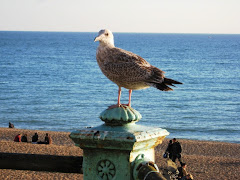That sometimes feels like a contradiction in terms given Brighton's reputation as being 'London-by-the-Sea', with its reputation for hedonism and sleazy goings-on. But of course it's easy to reach the beautiful Sussex countryside from Brighton - it's possible almost without thinking about it. Ten minutes takes you to the South Downs, and twenty takes you to the glorious Sussex Weald.
One of my favourite past-times when I'm in Sussex is visiting old churches. The County is rich in early mediaeval examples especially and, while they may lack the grandeur and wealth of the wool churches in Norfolk, Suffolk or Oxfordshire, or the stunning towers and woodwork of Somerset, they can more than make up for it in charm. Both Downs and Weald were poor until relatively recently, so many churches have survived relatively intact, without too many rebuildings. Even the Victorian period was relatively benign, although a few horrors still exist.
This week-end saw me biking along the A283 to two tiny villages I had not been to before, Sullington and Ashurst, both with equally small churches. Normally, it's a bit of a gamble visiting such places without calling ahead, as country churches are so often locked these days. But my luck was in, and both were open. I'm so glad they were, because they were among the loveliest I have visited in a long time.
First, Sullington: reached down a narrow lane off the A283 between the A24 and Storrington, this really does feel like a step back in time. The hamlet is tiny - just a few houses and a farm, with dramatic, sweeping views up towards the South Downs. The church appears around a corner, as if from nowhere: a perfect, small flint-walled building, with a squat tower, tall nave and short chancel, set in a churchyard full of ancient yews.

The church is equally ancient, dating from Saxon times, and contains a 13th century crusader tomb, complete with a rather badly mauled effigy. The church is beautifully maintained, and was filled with the most stunning flowers. Appropriately, next Saturday (28th June), there is a flower festival at the church.
The next stop was the tiny village of Ashurst, a few miles north of Steyning. Its parish church of St James really is a picture postcard: a stout flint tower wears a tall, octagonal spire, made of wooden shingles, rather like a hat. You might imagine it coming to life in some local fairy tale. The roof is all higgledy-piggledy, covered variously in red tiles and heavy Horsham slates. The churchyard was alive with bright summer flowers.

Inside is even more of a delight, especially to to any budding architectural historian, as the interior is as complex as any I have ever seen. An unusual feature is a huge 'king-post' roof, covering both nave and aisle, rising from the arcade, but it also has a lovely Sussex marble font and a 'Vamping Horn' - a sort of 18th century megaphone. The choir vestry was donated by Lord Laurence Olivier, who latterly lived and died in Ashurst, and whose funeral was held in St James.
On my way home, I felt truly lucky to have had the time and space to visit these lovely places. I have promised myself to return and attend a service, one day.



No comments:
Post a Comment